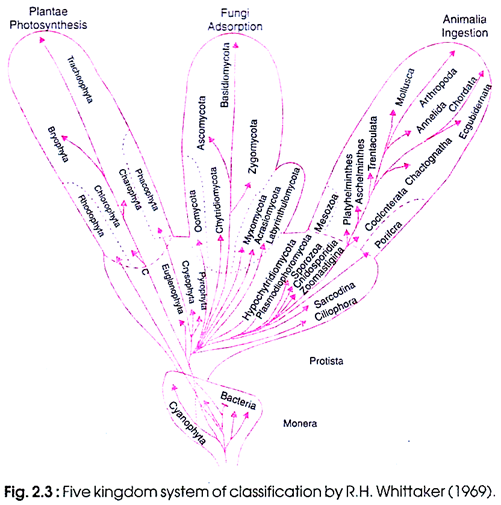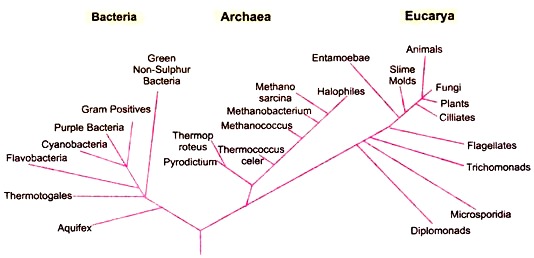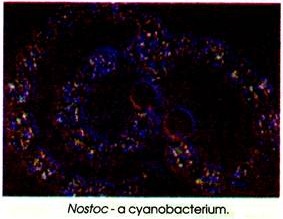ADVERTISEMENTS:
The following points highlight the three main system of classifications of microorganism. The system of classifications are: 1. Five-Kingdom System of Classifications 2. Eight Kingdom System of Classification 3. Three Domain System of Classification.
1. Five-Kingdom System of Classifications:
Later, prokaryotic and eukaryotic organisms were distinguished on the basis of cell anatomy, and the concept of a bacterium as a prokaryotic organism was established in microbiology in 1962 by Stamir and Van Niel. In 1969, Whittaker proposed a five kingdom system consisting of kingdom of plantae, fungi, animalia, protista and monera (Fig. 2.3) for all organisms on the basis of their energy- yielding systems and cell anatomy.
Microorganisms with the common characterstics described above are distributed in the kingdoms of monera, protista, fungi and a part of plants. Recently, evolutionary relationships of living organisms have been defined on the basis of ribosomal RNA sequences and other data.
The kingdom Monera of prokaryoteae includes all prokaryotic microorganisms. Protista consists of unicellular or multicellular eukaryotic organisms but true tissues are lacking. The kingdom Fungi contains eukaryotic and multinucleate organisms.
The members have absorptive mode of nutrition. Animalia contains multicellular animals devoid of cell wall. Ingestion is the mode of nutrition. The kingdom Plantae includes multicellular eukaryotes. Their mode of nutrition is the photosynthesis.
2. Eight Kingdom System of Classification:
Cavalier-Smith (1987, 1993) classified protists into eight kingdoms on the basis of ultrastructure of cell and genetic organisations (rRNA sequencing and other data). He divided all organisms into two empires (Bacteria and Eukaryota) (Fig. 2.4). The empire Bacteria includes two kingdoms (Eubacteria and Archaeobacteria). The empire Eukaryota contains six kingdoms (Archezoa, Protozoa, Plantae, Chromista, Fungi and Animalia).
ADVERTISEMENTS:
The kingdom Chromista includes diatoms, brown algae, crypto-monads and oomycetes. The members of Chromista are photosynthetic and have their chromoplast within the lumen of endoplasmic reticulum but not in cytoplasm.
3. Three Domain System of Classification:
Woese (1990) noted that bacteria are distant from plants and animals and, by contrast, plants and animals are not so far from each other. Therefore, they established a new superior concept of domains over the kingdom, and proposed three domains, Bacteria, Archaea and Eukarya in 1991 (Fig. 2.5).
Fig. 2.5 : Universal phylogenetic tree derived from comparative sequencing of 16S or 18S ribosomal RNA.
The domains Archaea and Eukarya are distinctly related to each other. Eukarya includes the organisms which possess glycerol fatty acyl-diester as membrane lipids and eukaryotic rRNA. The domain Bacteria consists of such members which have membrane lipids as diacyl glycerol diesters and eubacterial rRNA.
The member of domain Archaea consists of isoprenoid glycerol diester (or diglycerol tetraether) lipids in their membrane and archebacterial rRNA.
In a modern sense, bacteria, cyanobacteria, actinomycetes, etc. are distributed in the domain bacteria; methanogens extremely thermophilic organisms, extremely halophilic organisms, etc. are in the domain Archaea; and molds, yeasts, basidiomycetes, algae and protozoa, etc. in the domain Eukarya. Microorganisms are regarded as collections of evolutionary different organisms.




